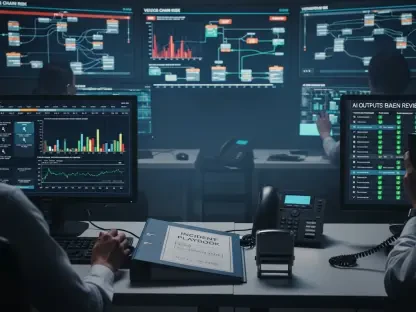In an era where technology dictates the pace of business, a staggering statistic emerges: since early 2025, over 60 securities class actions related to artificial intelligence (AI) and cyber breaches have been filed against major corporations, underscoring a critical shift in the executive liability insurance sector. This surge, particularly in Directors and Officers (D&O) coverage, highlights how companies increasingly rely on AI-driven systems and face relentless cyber threats, redrawing the traditional boundaries of risk. This report delves into how these emerging challenges are transforming insurance strategies, compelling insurers, boards, and executives to adapt to a landscape where technology governance is as vital as financial oversight.
The Evolving Landscape of Executive Liability Insurance
Executive liability insurance, with D&O coverage at its core, has long served as a safeguard for corporate leaders against claims of financial mismanagement and fiduciary breaches. This form of insurance protects directors and officers from personal losses arising from lawsuits related to their decision-making roles. Historically, the focus has centered on risks tied to balance sheets and shareholder disputes, ensuring that executives are shielded from the fallout of strategic missteps.
However, the rapid integration of AI and the escalating threat of cyberattacks have shifted the risk paradigm significantly. No longer confined to financial errors, liability now encompasses failures in technology oversight and cybersecurity preparedness. Insurers are reevaluating how to address these non-traditional risks, as a single data breach or AI misuse can trigger massive legal and reputational damage.
Key market players, including established insurers and new entrants, are navigating this complex terrain amid growing competition. The role of technology in business operations has never been more pronounced, with digital transformation becoming a cornerstone of corporate strategy. D&O insurance remains a critical tool for protecting executives, but its scope must evolve to meet the demands of a tech-driven world, highlighting the urgency for innovative approaches in coverage design.
Emerging Risks and Trends in D&O Coverage
Impact of AI and Cyber Threats
The integration of AI into corporate decision-making and the persistent rise of cyber threats are fundamentally altering the risk profiles for executives and boards. AI systems, while enhancing efficiency, introduce new vulnerabilities, such as biased algorithms or automated decisions leading to shareholder losses. Simultaneously, cyber incidents, from ransomware to data leaks, expose companies to regulatory penalties and litigation.
Trends in technology governance are gaining prominence, with boards facing increased scrutiny over their expertise in AI and cybersecurity. Investors and regulators now expect directors to demonstrate competence in overseeing these areas, as lapses can lead to claims of negligence. This shift is evident in the rising demand for specialized training and external audits to ensure robust oversight mechanisms are in place.
Litigation risks tied to AI and data breaches are on a steep upward trajectory. Since the start of 2025, over 60 AI-related securities class actions have been documented, alongside a comparable number of lawsuits stemming from cyber incidents. These figures illustrate the growing legal exposure for executives, emphasizing the need for insurance products that address these specific, technology-driven challenges head-on.
Market Dynamics and Growth Projections
The legal landscape reveals a clear trend: AI-related securities class actions and cyber breach lawsuits have surged dramatically in recent months. Data from early 2025 indicates that nearly two-thirds of Fortune 500 companies have referenced AI in their annual filings, making public disclosures a potential litigation trigger. This heightened transparency, while necessary, amplifies the risk of claims based on perceived misrepresentations.
Market competition is intensifying as new insurers enter the D&O space, spurred by the demand for innovative solutions. Established players are compelled to differentiate through advanced underwriting processes, leveraging data analytics to assess technology risks more accurately. This competitive pressure is reshaping the industry, pushing toward more tailored and responsive coverage options for clients.
Looking ahead, the demand for specialized D&O coverage is expected to grow as AI and cyber risks become even more pervasive. Projections suggest that between 2025 and 2027, the market for executive liability insurance will expand significantly, driven by the need for policies that address governance failures in technology adoption. Insurers must anticipate these shifts, ensuring their offerings remain relevant in an increasingly complex risk environment.
Challenges in Adapting to Technology-Driven Risks
Incorporating AI and cyber risk assessments into traditional D&O underwriting poses significant complexities for insurers. Conventional models, rooted in financial metrics, struggle to quantify the intangible impacts of technology failures or the cascading effects of a cyber incident. This gap necessitates a rethinking of risk evaluation frameworks to better capture the nuances of digital vulnerabilities.
A key challenge lies in the overlap and separation of cyber risks from D&O policies. While many insurers are carving out cyber breaches for standalone coverage, oversight failures by executives—such as inadequate cybersecurity protocols—often remain under D&O scope. Defining the boundaries of coverage in these scenarios is a persistent hurdle, leading to disputes over claim eligibility and policy interpretation.
Potential solutions include the development of enhanced governance frameworks and specialized risk management tools. Insurers can partner with technology experts to create assessment models that prioritize board preparedness and incident response capabilities. Additionally, offering advisory services alongside policies can help clients mitigate risks proactively, bridging the gap between traditional insurance and modern technological challenges.
Regulatory Volatility and Compliance Pressures
Rapid regulatory changes are adding another layer of complexity to executive liability, as policymakers grapple with the implications of AI and cyber advancements. Recent executive orders and policy shifts by bodies like the Securities and Exchange Commission (SEC) have introduced uncertainty, with reversals in diversity mandates and technology disclosure requirements catching many companies off guard. These fluctuations heighten the risk of non-compliance claims against executives.
Under employment practices liability (EPL), the stakes are equally high, with evolving discrimination and harassment regulations creating new exposure points. Shifts in federal and state-level policies on workplace equity demand constant vigilance from corporate leaders, as missteps can lead to costly litigation. Insurers must account for these dynamic risks when designing coverage, ensuring flexibility to adapt to sudden legal changes.
The role of insurers extends beyond risk transfer to active guidance on compliance complexities. By providing resources such as legal hotlines and regulatory updates, carriers can help clients navigate an unpredictable environment. This advisory function is becoming a critical differentiator in the market, as companies seek partners capable of addressing both technological and regulatory challenges with equal proficiency.
Future Directions for Executive Insurance Strategies
As AI and cyber risks continue to evolve, the structure of D&O coverage is likely to undergo further transformation. A debate persists over the necessity of standalone AI insurance, with some arguing it could address specific vulnerabilities not fully captured by existing policies. However, others caution that fragmentation might lead to coverage gaps, advocating for integrated solutions within broader D&O frameworks.
Emerging technologies, such as API-driven workflows, are poised to streamline underwriting and client services in the insurance sector. These tools enable real-time data integration, allowing insurers to assess risks more dynamically and respond to client needs with greater speed. Such innovations promise to enhance efficiency, positioning forward-thinking carriers as leaders in a competitive landscape.
Broader factors, including global economic conditions and regulatory trends, will also shape the industry’s trajectory. The demand for tailored risk solutions is expected to rise, driven by the unique challenges faced by companies in different sectors. Insurers must remain agile, balancing the need for specialization with the stability of comprehensive coverage to meet the diverse needs of their clients in the years ahead.
Conclusion and Strategic Recommendations
Reflecting on the insights gathered, it becomes evident that AI and cyber risks have fundamentally altered the landscape of executive liability insurance. The shift toward governance-focused underwriting, coupled with rising litigation and regulatory volatility, has placed unprecedented pressure on insurers to adapt. Market dynamics have intensified, with competition driving innovation as a key differentiator in an increasingly crowded field.
Moving forward, insurers should prioritize actionable strategies to stay ahead of these challenges. Developing collaborative partnerships with clients to enhance compliance frameworks emerges as a critical step, ensuring that policies align with regulatory expectations. Investing in technology-driven solutions, such as advanced analytics for risk assessment, offers a pathway to greater precision in underwriting.
Ultimately, positioning themselves as solution partners rather than mere risk carriers stands out as the most promising approach. By fostering innovation and tailoring offerings to address specific technology risks, insurers can build trust and relevance in a rapidly evolving market. These steps promise not only to mitigate current exposures but also to prepare the industry for the unforeseen complexities that lie on the horizon.









